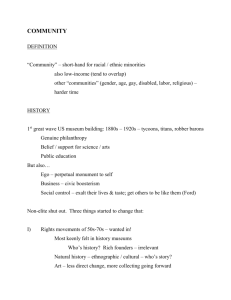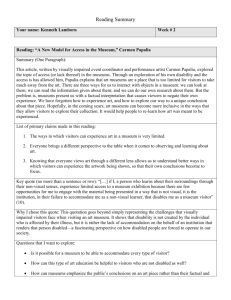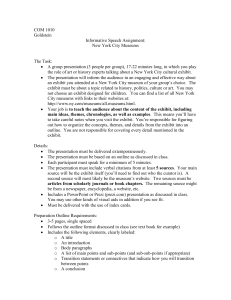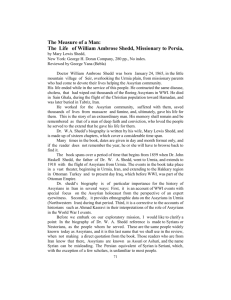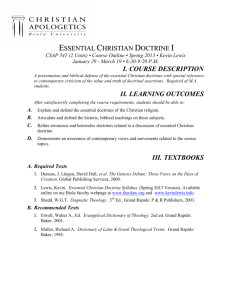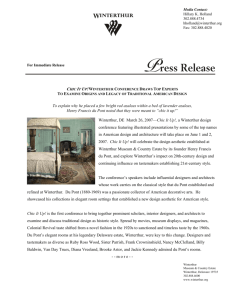Audience
advertisement
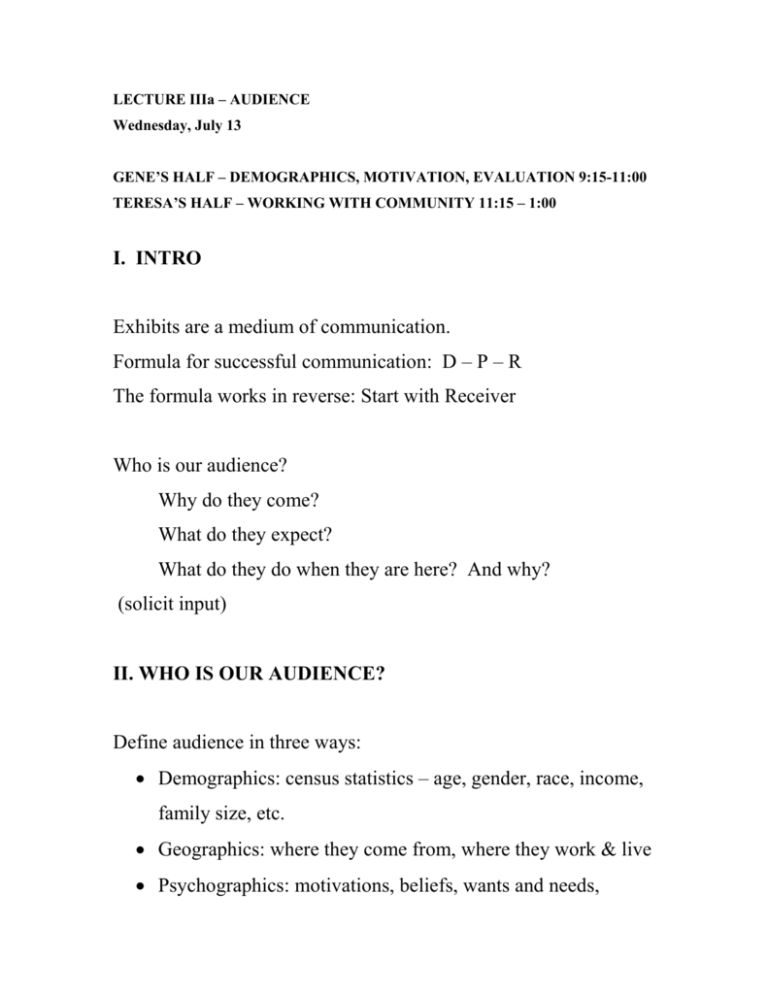
LECTURE IIIa – AUDIENCE Wednesday, July 13 GENE’S HALF – DEMOGRAPHICS, MOTIVATION, EVALUATION 9:15-11:00 TERESA’S HALF – WORKING WITH COMMUNITY 11:15 – 1:00 I. INTRO Exhibits are a medium of communication. Formula for successful communication: D – P – R The formula works in reverse: Start with Receiver Who is our audience? Why do they come? What do they expect? What do they do when they are here? And why? (solicit input) II. WHO IS OUR AUDIENCE? Define audience in three ways: Demographics: census statistics – age, gender, race, income, family size, etc. Geographics: where they come from, where they work & live Psychographics: motivations, beliefs, wants and needs, behavioral profile The better you know audience, the better you’ll be able to reach them. A good museum surveys audience every so often just to find out who’s coming. FMNH (Chicago) did a major survey in 1991; Shedd Aquarium 1998. Similar results. Some findings (DON’T WRITE DOWN): Demographics: 80% white (both) 50% first-time visitors (both) Groups with children: FMNH 1/3; Shedd ½ (summer survey) College degrees (adults): FMNH 1/2; Shedd 2/3 Males: FMNH 50%; Shedd 45% Geographics: Both drew heavily from surrounding area (Shedd: metro 1/3; Midwest 1/2; other 1/5) Average visit: FMNH 2 hours On and on. NOT IMPORTANT to know FMNH vs. Shedd IS IMPORTANT to know YOUR audience What do you do with this info? Extreme example: Winterthur: 2/3 female, avg age 60. Monster Truck exhibit. 1) Decline – not our audience. 2) Accept, shape content to appeal to audience 3) Accept, use exhibit to reach new audience (Reality: Winterthur is Decorative Arts) (Art of Motorcycle? TMLMTBGB at SMM?) Demographics and geographics are different for every museum, but in general: Overall, American museums appeal to educated, middle- and upper-class families Minorities under-represented, probably due to education / income variables NOTE: “educated” doesn’t mean “expert.” Visitors are smart enough to handle new info, but, the info IS NEW. Psychographics – interests, beliefs, motivations – tend to be uniform Value learning (but are NOT experts) Seek challenge / unique experience Doing something worthwhile with leisure time Important to distinguish cause and effect: College doesn’t make you go to museums Rather, placing value on learning makes people pursue education, formally and informally III. WHY DO THEY VISIT? So, people come to museums to learn, right? Depends on what you mean by “learn” Acquiring facts (formal education) – no. Books, web, TV better. Experience, making it real, getting inspired (informal ed.) – yes. Marketing perspective: what want or need does museum fulfill? Leisure time Typical museum visitor: wants to do something worthwhile w/ leisure, and considers educational activity worthwhile HOWEVER – primary, proximal motivation is always: SOCIAL OUTING SMM survey: top three reasons for coming: safe, inexpensive social outing see and do things you can’t do anywhere else hands-on, experiential learning The museum is just the setting; the time spent together is the true purpose. IV. WHAT DO THEY DO WHEN HERE? Visitor agenda: They come with a group; they want to BE with their group – interacting, talking, moving through together, seeing and experiencing together. Rand’s Bill of Rights: Puts exhibit in context of entire museum visit. Comfort Orientation Welcome Enjoyment Socializing Respect for Audience Clear, accurate info; feedback Learning styles Choice & Control Appropriate challenges Leave revitalized That’s all primary (bottom Maslow’s hierarchy of needs). Only after we have accomplished that do we have a “teachable moment” – our goal meets visitor’s desire. V. LEARNING Because they value learning, they would like to learn something, informally. So, how do people learn in museums? Entire classes dedicated to museum education. FIRST BIG POINT: Lots of theories about learning and education in general. [WHOSE IS THIS?] Summary from eduweb? Knowledge: external and objective vs. internal and subjective Learning: fed from outside vs. built from inside All of these happen, all the time. Appropriate in different circumstances. (Constructivist stoplight.) Nature of exhibit medium: Exhibit is FREE CHOICE – visitors may skip components, see them in any order. Non-linear. Variety of behavior: skimming, in-depth. Avg. time spent: 12 to 20 minutes. Given that museum visit is self-directed, non-linear, it’s harder to do left-hand side (at least, not all the time). Flavor of the month: Meaning-making (Constructivism) – build your own knowledge, incorporate it into your understanding. SECOND BIG POINT: different learning styles (Gardner article) Linguistic (reading) Logical / mathematical Spatial Musical Bodily / kinesthetic (touching, manipulating) Interpersonal (discussing) Intrapersonal (musing) Looking more broadly, there’s McCarthy’s taxonomy of learning styles: Imaginative learners (social) Analytic learners (factual) Common-sense learners (discovery) Experiential learners (trial-and-error) Memorizing list not as important as realizing different people have different preferences: How they take in information (Gardner) How they process it (McCarthy) A good exhibit must hit as many of these as possible. VI. HOW DO WE KNOW IF WE’VE SUCCEEDED? Evaluation: Front-end or concept testing Formative and prototyping Remedial and summative Methods: Questionnaires Closed Open Models, drawings, prototypes Timing and tracking Follow-up MUSEUM ATTITUDE TOWARD VISITORS: Doering’s vocabulary: Customer – commercial transaction Audience – passive receptacle Visitor – distant, unaffected Guest – welcome and accommodating, but still in charge “Friend” – equals. FMNH labels

